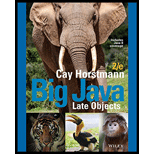
Explanation of Solution
Consider the given array declaration:
int[][] values = new int[ROWS][COLUMNS];
Fill all entries with “0”:
Java statements to fill all entries with “0” are as follows:
//Outer loop to refer rows of the array
for(int x = 0; x < ROWS; x++)
{
//Inner loop to refer columns of the array
for(int y = 0; y < COLUMNS; y++)
{
//Fill the array “values” with “0”
values[x][y] = 0;
}
}
Explanation:
In the above code,
- The outer “for” loop is used to refer the rows of the “values” array.
- The inner “for” loop is used to refer the columns of the “values” array.
- The statement “values[x][y] = 0;” is used to fill each element of the “values” array with “0”.
- The inner “for” loop is used to refer the columns of the “values” array.
Fill elements alternately with 0s and 1s in a checkerboard pattern:
Java statements to fill elements alternately with 0s and 1s in a checkerboard pattern are as follows:
//Outer loop to refer rows of the array
for(int x = 0; x < ROWS; x++)
{
//Inner loop to refer columns of the array
for(int y = 0; y < COLUMNS; y++)
{
//Fill the array “values” with “0”
values[x][y] = (x + y) % 2;
}
}
Explanation:
In the above code,
- The outer “for” loop is used to refer the rows of the “values” array.
- The inner “for” loop is used to refer the columns of the “values” array.
- The statement “values[x][y] = (x + y) % 2;” is used to fill elements of “values” array alternately with 0s and 1s in a checkerboard pattern.
- The inner “for” loop is used to refer the columns of the “values” array.
Fill only the elements at the top and bottom row with zeroes:
Java statements to fill only the elements at the top and bottom row with zeros are as follows:
//Outer loop to refer rows of the array
for(int y = 0; y < columns; y++)
{
//Assign top row with zeros
values[0][y] = 0;
//Assign bottom row with zeros
values[ROWS - 1][y] = 0;
}
Explanation:
In the above code,
- The “for” loop is used to refer the columns of the array...
Want to see the full answer?
Check out a sample textbook solution
Chapter 6 Solutions
Big Java Late Objects
- Complete the JavaScript function addPixels () to calculate the sum of pixelAmount and the given element's cssProperty value, and return the new "px" value. Ex: If helloElem's width is 150px, then calling addPixels (hello Elem, "width", 50) should return 150px + 50px = "200px". SHOW EXPECTED HTML JavaScript 1 function addPixels (element, cssProperty, pixelAmount) { 2 3 /* Your solution goes here *1 4 } 5 6 const helloElem = document.querySelector("# helloMessage"); 7 const newVal = addPixels (helloElem, "width", 50); 8 helloElem.style.setProperty("width", newVal); [arrow_forwardSolve in MATLABarrow_forwardHello please look at the attached picture. I need an detailed explanation of the architecturearrow_forward
- Information Security Risk and Vulnerability Assessment 1- Which TCP/IP protocol is used to convert the IP address to the Mac address? Explain 2-What popular switch feature allows you to create communication boundaries between systems connected to the switch3- what types of vulnerability directly related to the programmer of the software?4- Who ensures the entity implements appropriate security controls to protect an asset? Please do not use AI and add refrencearrow_forwardFind the voltage V0 across the 4K resistor using the mesh method or nodal analysis. Note: I have already simulated it and the value it should give is -1.714Varrow_forwardResolver por superposicionarrow_forward
- Describe three (3) Multiplexing techniques common for fiber optic linksarrow_forwardCould you help me to know features of the following concepts: - commercial CA - memory integrity - WMI filterarrow_forwardBriefly describe the issues involved in using ATM technology in Local Area Networksarrow_forward
- For this question you will perform two levels of quicksort on an array containing these numbers: 59 41 61 73 43 57 50 13 96 88 42 77 27 95 32 89 In the first blank, enter the array contents after the top level partition. In the second blank, enter the array contents after one more partition of the left-hand subarray resulting from the first partition. In the third blank, enter the array contents after one more partition of the right-hand subarray resulting from the first partition. Print the numbers with a single space between them. Use the algorithm we covered in class, in which the first element of the subarray is the partition value. Question 1 options: Blank # 1 Blank # 2 Blank # 3arrow_forward1. Transform the E-R diagram into a set of relations. Country_of Agent ID Agent H Holds Is_Reponsible_for Consignment Number $ Value May Contain Consignment Transports Container Destination Ф R Goes Off Container Number Size Vessel Voyage Registry Vessel ID Voyage_ID Tonnagearrow_forwardI want to solve 13.2 using matlab please helparrow_forward
 Database System ConceptsComputer ScienceISBN:9780078022159Author:Abraham Silberschatz Professor, Henry F. Korth, S. SudarshanPublisher:McGraw-Hill Education
Database System ConceptsComputer ScienceISBN:9780078022159Author:Abraham Silberschatz Professor, Henry F. Korth, S. SudarshanPublisher:McGraw-Hill Education Starting Out with Python (4th Edition)Computer ScienceISBN:9780134444321Author:Tony GaddisPublisher:PEARSON
Starting Out with Python (4th Edition)Computer ScienceISBN:9780134444321Author:Tony GaddisPublisher:PEARSON Digital Fundamentals (11th Edition)Computer ScienceISBN:9780132737968Author:Thomas L. FloydPublisher:PEARSON
Digital Fundamentals (11th Edition)Computer ScienceISBN:9780132737968Author:Thomas L. FloydPublisher:PEARSON C How to Program (8th Edition)Computer ScienceISBN:9780133976892Author:Paul J. Deitel, Harvey DeitelPublisher:PEARSON
C How to Program (8th Edition)Computer ScienceISBN:9780133976892Author:Paul J. Deitel, Harvey DeitelPublisher:PEARSON Database Systems: Design, Implementation, & Manag...Computer ScienceISBN:9781337627900Author:Carlos Coronel, Steven MorrisPublisher:Cengage Learning
Database Systems: Design, Implementation, & Manag...Computer ScienceISBN:9781337627900Author:Carlos Coronel, Steven MorrisPublisher:Cengage Learning Programmable Logic ControllersComputer ScienceISBN:9780073373843Author:Frank D. PetruzellaPublisher:McGraw-Hill Education
Programmable Logic ControllersComputer ScienceISBN:9780073373843Author:Frank D. PetruzellaPublisher:McGraw-Hill Education





